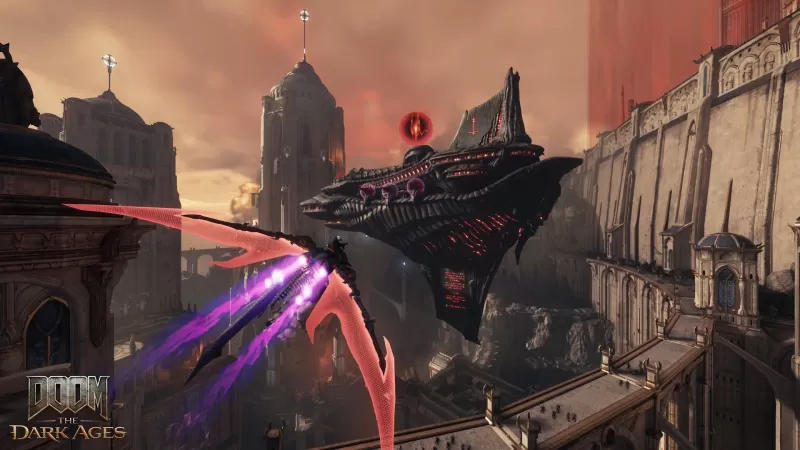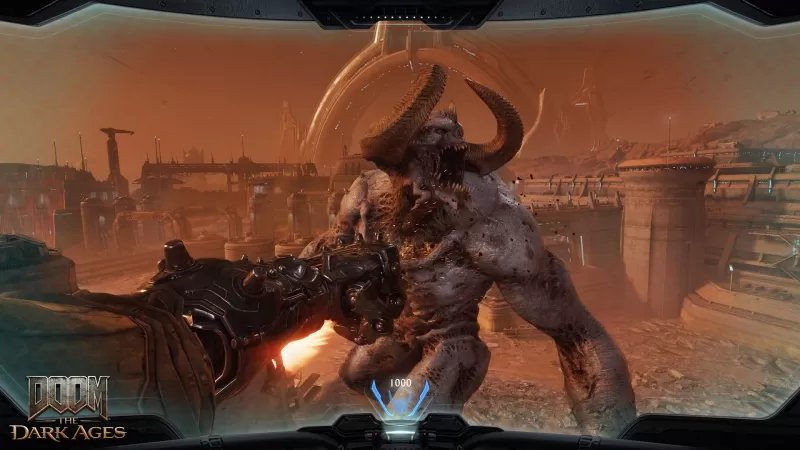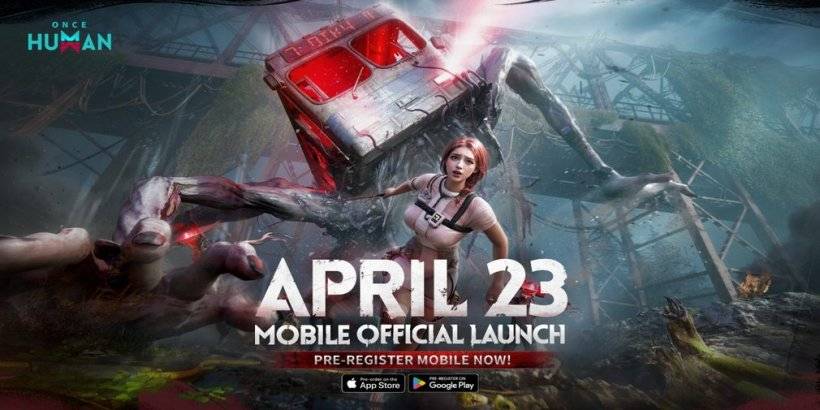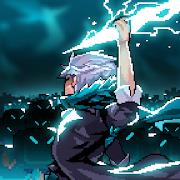I never expected *Doom: The Dark Ages* to evoke memories of *Halo 3*, yet here I am, recounting a thrilling hands-on demo with id Software's gothic prequel. Mid-demo, I found myself astride a cyborg dragon, unleashing a barrage of machinegun fire at a demonic battle barge. After obliterating its defensive turrets, I landed atop the vessel, charging through its lower decks and reducing the crew to mere red slush. Moments later, the warmachine was destroyed, and I burst through its hull, leaping back onto my dragon to continue my relentless crusade against Hell's machines.
Fans of Bungie's iconic Xbox 360 shooter will recognize the essence of Master Chief's assault on the Covenant's scarab tanks. While the helicopter-like Hornet has been replaced by a holographic-winged dragon and the giant laser-firing mech by an occult flying boat, the core experience remains: a thrilling aerial assault transitioning into a devastating boarding action. Surprisingly, this wasn't the only *Halo*-like moment in the demo. While *The Dark Ages*' combat core is unmistakably *Doom*, its campaign design feels reminiscent of late-2000s shooters, with elaborate cutscenes and a push for gameplay novelty.
 A dragon assault on Hell's battle barge. | Image credit: id Software / Bethesda
A dragon assault on Hell's battle barge. | Image credit: id Software / Bethesda
Over two and a half hours, I experienced four levels of *Doom: The Dark Ages*. The first level, the campaign's opener, echoed the tightly-paced, meticulously-designed maps of *Doom (2016)* and its sequel. The subsequent levels saw me piloting a colossal mech, soaring on the dragon, and navigating a vast battlefield filled with secrets and powerful minibosses. This marks a significant departure from *Doom*'s traditional focus on mechanical purity, feeling more akin to *Halo*, *Call of Duty*, and even old James Bond games like *Nightfire*, which thrive on scripted setpieces and novel mechanics.
This new direction for *Doom* is fascinating, especially considering the series once veered away from such elements. The cancelled *Doom 4* was envisioned to resemble *Call of Duty* in both its modern military aesthetic and emphasis on characters, cinematic storytelling, and scripted events. Id Software ultimately rejected these ideas for *Doom (2016)*, yet here they are, reimagined in *The Dark Ages* in 2025.
The campaign's rapid pace is punctuated with innovative gameplay elements reminiscent of *Call of Duty*'s biggest novelties. My demo began with a long, elaborate cutscene reintroducing the realm of Argent D'Nur, the opulent Maykrs, and the Night Sentinels—the Doom Slayer's knightly brothers-in-arms. Portrayed as a terrifying legend, the Slayer's presence feels like a nuclear-level threat. While this lore will be familiar to *Doom* enthusiasts, its deeply cinematic presentation feels new and reminiscent of *Halo*. This extends to the levels, where NPC Night Sentinels are scattered throughout, akin to UNSC Marines, enhancing the sense of being part of a larger force.
The introductory cutscene's extensive character work raises questions about its necessity in *Doom*. I prefer the subtle storytelling approach of the previous games, conveyed through environment design and codex entries, with cinematics reserved for significant reveals, as seen in *Eternal*. However, the cutscenes in *The Dark Ages* serve their purpose well: they set up missions without disrupting the game's intense flow.
Post the opening mission, which began with intense shotgun battles and ended with parrying Hell Knights using the Slayer's new shield, I found myself in the cockpit of a Pacific Rim-like Atlan mech, wrestling demonic kaiju. Next, I was soaring on the cybernetic dragon, attacking battle barges and destroying gun emplacements. These tightly scripted levels introduce significant shifts in gameplay, reminiscent of *Call of Duty*'s iconic sequences like *Modern Warfare*'s AC-130 gunship mission or *Infinite Warfare*'s dogfighting. The Atlan is slow and heavy, while the dragon is fast and agile, each offering a unique experience far removed from classic *Doom*.
 The mech battles are Pacific Rim-scale punch ups. | Image credit: id Software / Bethesda
The mech battles are Pacific Rim-scale punch ups. | Image credit: id Software / Bethesda
Many top FPS campaigns thrive on such variety, with *Half-Life 2* and *Titanfall 2* setting the standard. *Halo*'s enduring appeal lies partly in its mix of vehicular and on-foot sequences, providing a rich texture. However, I'm uncertain if this approach will work for *Doom*. Like *Eternal*, *The Dark Ages* offers a complex shooter experience, demanding constant attention as you juggle shots, shield tosses, parries, and brutal melee combos. In contrast, the mech and dragon sequences feel less engaging, almost like on-rails QTEs.
In *Call of Duty*, switching to a tank or gunship works because the mechanical complexity isn't far removed from on-foot missions. In *The Dark Ages*, however, the disparity between gameplay styles is stark, akin to comparing a middle school guitar student to Eddie Van Halen. When battling giant demons with a rocket-powered mech punch, I found myself longing to return to the ground with a double-barrelled shotgun.
The final hour of play introduced "Siege," a level that refocuses on id's exemplary gunplay but expands the typically claustrophobic *Doom* level design into a vast, open battlefield. The objective—to destroy five Gore Portals—mirrors *Call of Duty*'s multi-objective missions, yet it also evokes *Halo*'s contrast between interior and exterior environments. Here, the core shooter systems are given new context in larger spaces, requiring you to rethink weapon ranges, employ charge attacks to cover vast distances, and use the shield to deflect artillery.
Expanding *Doom*'s playspace can lead to unfocused moments, with backtracking and empty pathways disrupting the pace. I believe integrating the dragon into this level, much like *Halo*'s Banshee, could enhance the pace and make the dragon a more integral part of the experience. If such a level exists beyond what I've seen, it could be a game-changer.
Despite the mixed reception to these new ideas, the core of *The Dark Ages* remains its intense, on-foot combat. Nothing in the demo suggested it won't be the star, and everything I played confirms it's another fantastic reinvention of *Doom*'s essence. While I'm skeptical about some of the new, mechanically simpler sequences, I'm also excited to see if id Software can successfully integrate these elements into the modern *Doom* formula. I eagerly await May 15th, not just to revel in id's unmatched gunplay but to see if *Doom: The Dark Ages* can deliver a cohesive late-2000s FPS campaign or if it will be a messy one.

 A dragon assault on Hell's battle barge. | Image credit: id Software / Bethesda
A dragon assault on Hell's battle barge. | Image credit: id Software / Bethesda The mech battles are Pacific Rim-scale punch ups. | Image credit: id Software / Bethesda
The mech battles are Pacific Rim-scale punch ups. | Image credit: id Software / Bethesda LATEST ARTICLES
LATEST ARTICLES 











